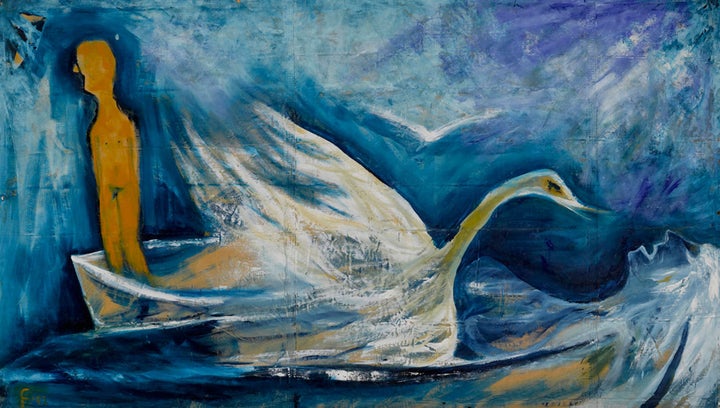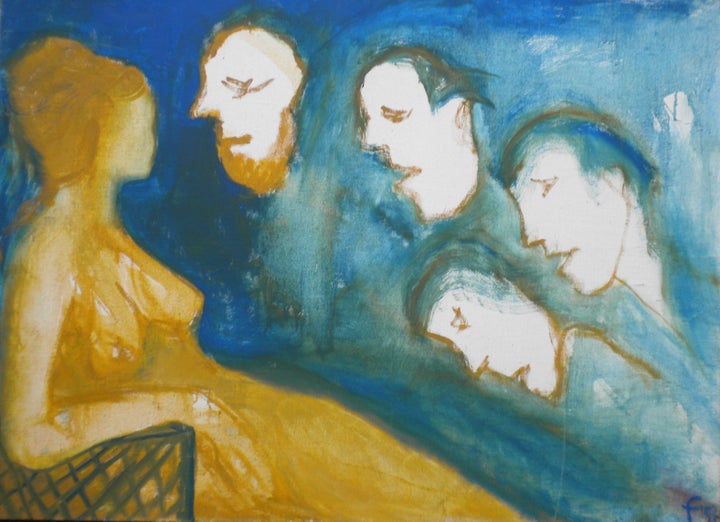
“I have always wanted to paint like Motherwell,” Lawrence Ferlinghetti explains when talking about his generation’s New York School of painting —“but then the damn figure just keeps entering in.” On a sweltering Indian summer afternoon at Rena Bransten Gallery in San Francisco, the legendary poet and City Lights bookstore founder and publisher, age 97, and I sat down to talk about his painting.
“I wrote my thesis on J.M.W. Turner at Columbia and right after that went to Paris on the G.I. bill where I started to paint,” Ferlinghetti reminds me as we pepper our conversation with French, his mother-tongue and Italian, his father-tongue. An avowed Parisian, where he lived from 1947-1951, and maintained a life-long literary and personal relationship with Shakespeare and Company bookstore’s founder George Whitman and his daughter Sylvia—Ferlinghetti’s painting has, however, been more celebrated in Italy with numerous monographs and museum shows. A comprehensive survey of Ferlinghetti’s painting can be found in Lawrence Ferlinghetti: 60 Years of Painting (Silvana, 2010) by Giada Diano and Elisa Polimeni and an upcoming show in Verona at the Accademia del Arte features his playful and political graffiti-like sayings painted over nightgowns and boxer shorts. “Fuck Art, Let’s Dance” is one of my favorites in the “Underwear” series as it really encapsulates Ferlinghetti’s enduring countercultural esprit and love of life.
In San Francisco, viewing the dramatic group of mural-sized paintings made on scavenged tarpaulins and organized under the title “Censored Tarps” 1992 now on view at Rena Bransten’s Gallery through October 15th, I am struck by how much Ferlinghetti’s work feels like part of the Italian 1980s Transavanguardia revival of expressionist painting with the distinct Chia, Clemente and Cucchi scale and attention to the female figure and a penchant for the allegorical. This may be the very reason the Italians have embraced Ferlinghetti the painter--in many ways he seems to share in a distinctly Italian 20th century painting tradition although, true to his radical activist roots, he creates paintings that are more explicitly political.
“Take “Liberty on Earth (Liberty #1),” Ferlinghetti explains to me, “It may look like an idealistic painting of the Statue of Liberty, but she is standing on the Middle East and there are black crosses hovering on the left and if you read A People’s History of the United States:1492-Present by Howard Zinn then you know the Statue of Liberty actually becomes a symbol of the enemy because every victory of capitalism is a defeat for the poor.” In a second tarp painting entitled “The Upper Classes” all the figures are blind and a Picasso-esque line drawing in the right hand corner is clearly borrowed from the iconic anti-war painting “Guernica.” When discussing his exquisite “Swan Song“ based on the myth Leda and the Swan, Ferlinghetti mentions “feminism” as a prism through which to read the painting.
“Can we live without painting?” I ask Ferlinghetti the question I provoke painters with and his answer is indirect. “The best paintings exist in relation to the history of painting. The problem today is that this history is lost on most people.” When I probe further into his dual artistic practices he elaborates, “My poetry is very visual but I try to keep my paintings totally separate. In other words, I don’t try to do paintings that are illustrations. I have done too many paintings that are like cartoons and I have thrown them out because cartoons are a different art form. My painting is purely about the excitement of the visual image.”
Currently Ferlinghetti’s painting “Deux” (1950) is on view in the Beat Generation exhibition at the Centre Pompidou in Paris. Associated with the international Fluxus movement through the Archivio Francesco Conz in Verona, Ferlightetti coined the verb “fluxare”, meaning to make love without touching, which is now an official part of the Italian vocabulary. However, Ferlinghetti is most notably affiliated with the Beat writers and the defense of Allen Ginsburg’s Howl as its publisher in 1956. “The question in this summer’s Beat Generation show at the Pompidou is really “Whose Beats?” Lawrence jokes, “The curator of the show Jean-Jacques Lebel is an old friend of mine. We participated in art happenings at the American Center in Paris in the 50s together with John Cage and Rauschenberg and others. Lebel curated the show around his own particular geography. For Lebel San Francisco is just an aside in Beat history and all roads instead lead to Paris.”
Ferlinghetti reminds me of my own teen-age years spent in North Beach working on week-ends as an aspiring poet/barista at the Café Trieste, taking my lunch breaks in the sexy book stacks on the lower floor of City Lights, stealing passages from George Bataille’s Story of the Eye and kisses from my wanna-be-writer boyfriend. In my humble opinion, all roads actually may lead to Lawrence Ferlinghetti.

